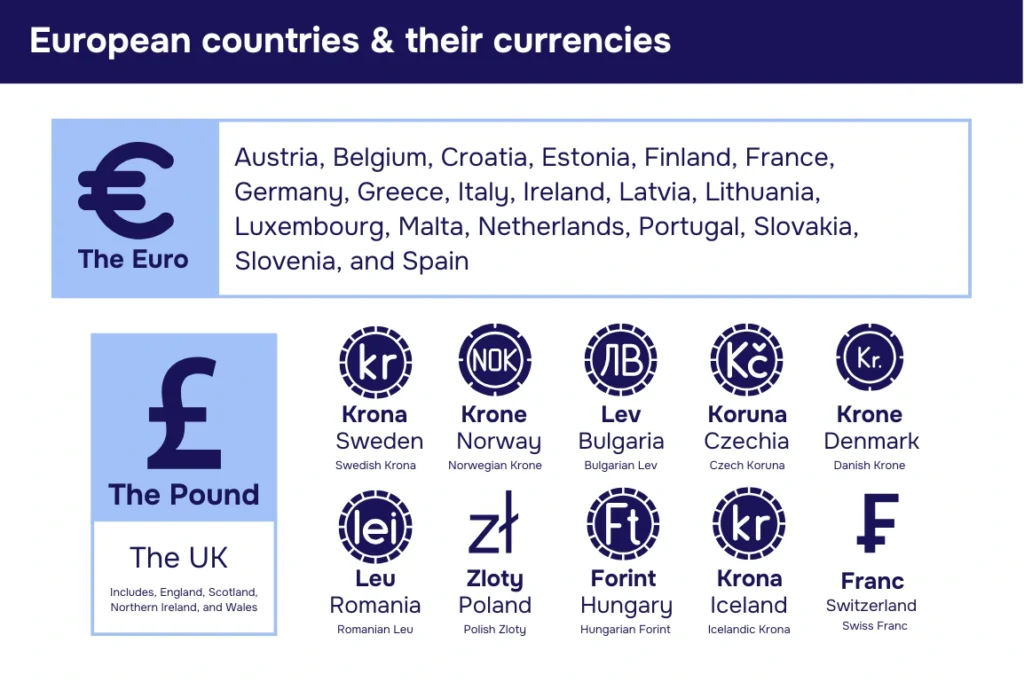Home > Understanding the Currency of the Schengen Area
Understanding the Currency of the Schengen Area
Before traveling to Europe, there are a ton of different things you need to think about. One of those things that can be easily overlooked is currency!
More likely than not, the currency in the Schengen area (a group of 29 countries) will be different than the currency you're used to back home.
On top of all of the normal things when traveling, like your hotel room, Schengen travel insurance, and airplane tickets, there are expenses you can expect to pay during your trip, like tickets for activities and meals at restaurants. This is where currency becomes so important.
It might surprise you to know that there isn’t a standard European currency – and that, in fact, the currency of Schengen member states varies from country to country.
While the Euro is the most common currency for Schengen countries, not every country in Europe uses it.
In this article, we will cover the currency of each country in the Schengen zone and provide you with answers to common questions such as "What currency does Austria use?" or "Does Denmark use the euro?" (psst… it doesn’t!)

Schengen countries and their currencies
You might be glad to hear that the euro (€) is the official currency for most of the countries in the Schengen area, which makes traveling between countries even simpler. This commonality helps eliminate the need to find a currency exchange or order currency through your bank ahead of time.
However, the euro isn’t the official currency for all of them. Below, you'll find the local currency of each country in the area in alphabetical order.
The currency in Austria
The euro (€). Austria uses the euro as its official currency.
When visiting Vienna, Salzburg, or anywhere else in Austria, you'll be using euros for all your transactions. Before switching over to the euro (in 1999), Austria’s official currency was the Austrian schilling.
Most establishments in Austria accept major debit and credit cards, allowing you to easily transact, no matter where you’re traveling from.
The currency in Belgium
The euro (€). Belgium, including its capital Brussels, uses the euro. Belgium has been using the euro since 1999. Before that, Belgium's official currency was the Belgian franc.
The majority of establishments in Belgium accept debit and credit cards.
The currency in Bulgaria
The Bulgarian lev (BGN). Bulgaria uses the Bulgarian lev, not the euro. However, it is pegged to the euro at a fixed exchange rate, making it easier for quick currency conversions.
When making purchases in Bulgaria, debit and credit cards are widely used. That said, smaller restaurants and stores, even in major cities, may not take cards. Because of that, it’s always a good idea to carry some lev when traveling to Bulgaria.
The currency in Croatia
The euro (€). Croatia is a more recent adopter of the euro as its official currency, doing so in January 2023. Euros are now widely used throughout the country, making it easier for tourists from other Schengen countries (or elsewhere) to visit and explore.
Before their recent adoption of the euro, Croatia’s official currency was the Croatian kuna.
The currency in Czechia
The Czech Koruna (CZK), not the euro, is the official currency of the Czech Republic. This means that the currency in Prague (Czechia's capital city) is also the Koruna.
Debit and credit cards, including Apply Pay and Google Wallet, are widely accepted in the Czech Republic.

The currency in Denmark
Denmark uses the Danish krone (DKK), not the Euro. If you’re traveling to Copenhagen or any other city in Denmark, you’ll be using Krones for all of your transactions.
Most establishments in Denmark will accept debit or credit.
The currency in Estonia
The euro (€). Estonia adopted the euro in 2011, and it has been the country’s official currency ever since. Before they adopted the euro, Estonia’s currency was the Estonian kroon.
Shopping and paying for services in Estonia is easy as debit cards are widely accepted, including more digitized methods, such as Apple Pay.
The currency in Finland
The euro (€). Finland has used the euro since 1999. So, if you're visiting Helsinki or any other Finnish city, you will be using euros for your transactions. Before 1999, Finland’s currency was the Finnish markka.
The currency in France
The euro (€). France, one of the most popular countries in the Schengen area, uses the euro. Whether you're shopping in Paris or exploring the countryside, you'll use euros. Before France adopted the euro, France’s official currency was the franc.
When you’re traveling in France, you’ll find that debit and credit cards are widely used and accepted.
The currency in Germany
The euro (€). Germany is one of the most visited countries in Europe, and it also uses the euro! Whether you’re traveling to Munich, Frankfurt, Berlin, or somewhere else, you can use euros for all of your transactions.
Before Germany switched to the Euro, their official currency was the Deutsche mark.
The currency in Greece
The euro (€). Greece adopted the euro in 2001. Tourists visiting the ancient ruins and islands can easily transact using euros, including debit and credit cards. It never hurts to carry some cash on you, however, just in case.
Before Greece began using the euro, its currency was the Greek drachma.
The currency in Hungary
Hungary uses the Hungarian forint (HUF), not the euro. If you’re traveling to Budapest or anywhere else in Hungary, you’ll be making transactions with the forint.
Most shops, hotels, and restaurants in Hungary (especially in city centers) accept debit and credit cards.
The currency of Iceland
Iceland uses the Icelandic krona (ISK), not the euro. If you’re planning a trip to Reykjavik, or anywhere else on the stunning island of Iceland, you’ll be making transactions with the Icelandic krona.
Iceland is very digitally modern, and you should have no problem using your debit or credit card when traveling.

The currency in Italy
The euro (€). Italy is part of the Schengen zone and has used the euro since 1999. If you're in Rome, Venice, Florence, or anywhere else in Italy, you will be using euros for your purchases.
Before Italy adopted the euro, the Italian lira was used.
Debit and credit are widely used in Italy, though it never hurts to have a few euros on you, especially at markets or in more rural locations.
The currency of Latvia
The euro (€). Latvia switched to the euro in 2014. If you're visiting Riga or any other part of the country, you'll use euros just like in many other Schengen countries. Before switching to the euro, the currency in Latvia was the Latvian lats.
When traveling to Latvia, major debit cards are widely accepted, especially at touristic locations such as hotels or downtown neighborhoods. However, many smaller shops and restaurants, especially outside of tourist areas, may not accept debit cards, so it’s best to have some cash on you when traveling through Latvia.
The currency of Liechtenstein
Liechtenstein uses the Swiss franc (CHF), sharing its currency with neighboring Switzerland.
Generally speaking, debit and credit cards are accepted in Liechtenstein. However, if you’re traveling to the countryside or small towns, it’s best to have some francs with you in case you pop in somewhere that doesn’t have a card reader.
The currency of Lithuania
The euro (€). Lithuania adopted the euro in 2015. Whether you're visiting Vilnius or smaller cities, euros are widely accepted. Before the euro was adopted as Lithuania’s official currency, the Lithuanian litas was used.
Major debit cards are widely used in Lithuania, but cash is also still widely used, especially at smaller "mom and pop" shops, restaurants, and street markets. It’s best to make sure you have a few euros on hand.
The currency of Luxembourg
The euro (€). Before adopting the euro, Luxembourg’s official currency was the Luxembourgish franc, which they shared with neighboring Belgium at a 1:1 exchange rate.
Debit and credit cards are widely used in Luxembourg.
The currency of Malta
The euro (€). The small island nation of Malta uses the euro. Before switching to the euro, Malta’s official currency was the Maltese lira.
Debit and credit are very common for transactions in Europe, though for some small purchases, cash is still common as well.
The currency of the Netherlands
The euro (€). The euro is the official currency of the Netherlands, which includes popular cities like Amsterdam.
Before the euro, the Netherlands used the Dutch guilder as its national currency.
Digital payment methods like Apple Pay and Google Wallet are very common in the Netherlands, as well as credit and debit cards. You should have no problem getting around.
The currency of Norway
Norway uses the Norwegian krone (NOK), not the euro. If you’re traveling to Oslo, Bergen, or anywhere else in Norway, you’ll be making transactions with the krone.
You should have no problem using debit and credit cards for your travels in Norway, but, like other Schengen countries, it never hurts to carry some cash on you just in case.
The currency of Poland
Poland uses the Polish złoty (PLN), not the euro. If you’re traveling in Poland, whether it’s Warsaw or somewhere else, you’ll be using the zloty for your purchases and transactions.
In general, you should be fine using your debit or credit card in Poland, but it never hurts to carry a small amount of cash on you just in case.
The currency of Portugal
The euro (€). Portugal adopted the euro as their official currency in 1999. Whether you're in Lisbon or Porto, you can use euros for all transactions. Before they adopted the euro, their official currency was the Portuguese escudo.
Debit card usage is very common (and expected) in Portugal, but it never hurts to have a few euros on hand.
The currency of Romania
Romania uses the Romanian leu (RON) as its official currency, not the euro. When traveling to Romania, you should make your purchases with the leu.
You’ll find that debit and credit cards are widely accepted in Romania.
The currency of Slovakia
The euro (€). Slovakia has been using the euro since 2009. Tourists visiting Bratislava, or any other city in Slovakia can expect to use Euros. Before they switched to the euro, Slovakia’s official currency was the Slovak koruna.
The most popular payment method in Slovakia is by debit or credit card.
The currency of Slovenia.
The euro (€). Slovenia adopted the euro in 2007. If you're traveling to Ljubljana or other Slovenian cities, euros will be the currency in use. Before switching to the euro, Slovenia’s official currency was the Slovenian tolar.
Debit cards are widely accepted in Slovenia.

The currency of Spain
Spain, a popular travel location, uses the euro (€). Whether you're in Madrid or Barcelona, you will use euros for all of your transactions. Before the euro became its official currency, Spain’s currency was the Spanish peseta.
Debit cards are widely accepted in Spain, but it’s a good idea to carry cash if you’re going to be traveling to small towns and villages or shopping at street markets.
The currency of Sweden
Sweden does not use the Euro, it uses the Swedish krona (SEK). When traveling to Stockholm, Gothenburg, or anywhere else in Sweden, you’ll be making transactions with the krona.
You should be fine using your debit or credit card around Sweden, as they are very popular and widely accepted.
The currency of Switzerland
Switzerland uses the Swiss franc (CHF), the same as its neighboring country of Liechtenstein. When traveling through Switzerland, from cities like Geneva to adventures in the Swiss Alps, you’ll be using the Swiss franc.
You should be absolutely fine using your debit or credit card through Switzerland, as they’re widely accepted around the country.